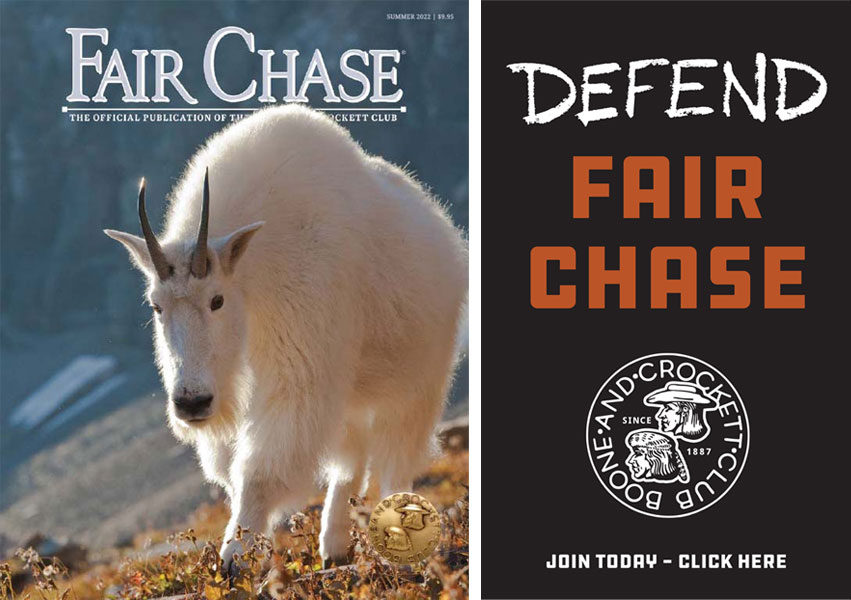A Little Help From Our Friends
SCIENCE BLASTS
By John F. Organ, B&C Professional MemberExcerpt from Spring 2015 issue of Fair Chase
My good friend Curtis Taylor, West Virginia’s State Fish and Wildlife Director, tells it this way: his cousin Ditto, so named by his parents becausehewasthespitting image of his older brother when he was born, wanted to avenge a boy named Clarence for bullying his daughter at school. So he, along with his daughter and son, hopped in his pickup and proceeded to head up into a holler well off the beaten path where this boy supposedly lived. Ditto had never been up this holler before, and had never seen this boy. After crossing under a train overpass he abruptly stopped the truck, turned around, and headed back down to the valley. Ditto’s son asked “Dad, why are we turning back? I thought we were going to teach that boy a lesson?” Ditto replied “Didn’t you see that sign on the overpass? It said Clarence 9 feet 3 inches! Some things you can’t do by yourself—you need your friends to help you!”
Spelling challenges aside, Curtis used this story to illustrate research partnerships that involved several states, agencies, and universities which advanced science and management of wild turkeys and ruffed grouse in the central Appalachians. This sameapproachisbeingapplied to big game in the West, and the hunter-conservationists that comprise the Boone and Crockett Club membership have reason to be excited over the outcomes that will be realized: science-driven management ensuring viable big game populations.
I will highlight one example, the Western Elk Research Collaborative (WERC),to whet your appetite for a feature article on this in a forthcoming issue of Fair Chase. WERC was the original idea of Pete Zager, a wildlife biologist now retired with Idaho Department of Fish and Game. His thought was that states have lots of data on elk that are nonetheless limited individually in terms of the timeframes studied and their geographic extent (spatial and temporal scope)—what could we do if the states pooled those data? This magically coincided with the Cooperative Fish and Wildlife Research Unit Program’s (Coop Units) strategic push to develop transboundary, multi-unit/multi-state projects. Research wildlife biologists Mike Mitchell and Matt Kauffman at the Montana and Wyoming Coop Units began working with elk biologists in seven western states. WERC has since been tremendously fruitful. From a management perspective, the northwestern states have likely never communicated or collaborated more with each other. All the state participants in WERC cite this as one of the best outcomes of this effort.
Scientifically, the group isaccomplishingfarmorethan any one elk research project ever could. Given changes in habitat and predator communities over the course of the huge data set they are working with, inferences on elk ecology and management that were previously impossible are being realized. Importantly, the temporal span of the data set actually lets them ask meaningful questions about many ecological aspects, including climate change. To date, Rocky Mountain elk data from Colorado, Idaho, Montana, Oregon, Utah, Washington, Wyoming, and Yellowstone National Park have been collected. The group has developed a set of shared objectives, data-sharing agreements, and decision- making protocols to facilitate large-scale, multi-region analyses of the factors affecting dynamics of the populations they manage. Additional projects by the Wyoming Coop Unit are investigating depressed elk pregnancy rates, monitoring population dynamics and migration patterns of elk in northwest Wyoming, and investigating how hunters and elk change their use of the forest as trees die and begin to fall due to bark beetle infestations. Studies by the Montana Coop Unit are designed to provide better understanding of elk and wolf predator-prey interactions, the effects of climate change and elk browsing on population trajectories and trophic interactions in riparian systems,andtheeffectsofelk on small mammals and nutrient cycling. The next step is the brass ring that ties it all together—the synthesis of elk demography, life history, habitat, and survival, which is unprecedented.
What Mitchell and Kaufmannwilltellyouisthat the absolute key to the success of WERC was state leadership. The states told the Coop Unit scientists and other university academics what they needed and envisioned, and they all worked together to get the job done—this is the essence of Coop Unit work, bringing man- agers and researchers together. So, to conclude, the proof in the pudding will be the response of elk to management—management driven by science enabled by data encompassing seven states over a long period of time. The bigger success story may be that of managers and Coop Unit scientists working together across political boundaries over large landscapes to accomplish some really, really big stuff, and creating oppor- tunities to mirror the work with moose and other big game. This is the model for the future of wildlife research, and the future is now, true to the Roosevelt Doctrine and the pillar of the North American Model that places science as the tool to discharge wildlife policy. So Curtis’s cousin was right—sometimes you just can’t get what you need done without help from your friends. Ditto that!
More Science Blasts
Read more articles about conservation, hunting, and wildlife research by John Organ, Director Emeritus of the USGS Cooperative Fish and Wildlife Research Units, and current B&C professional member.
Interested in More?
Image

|
